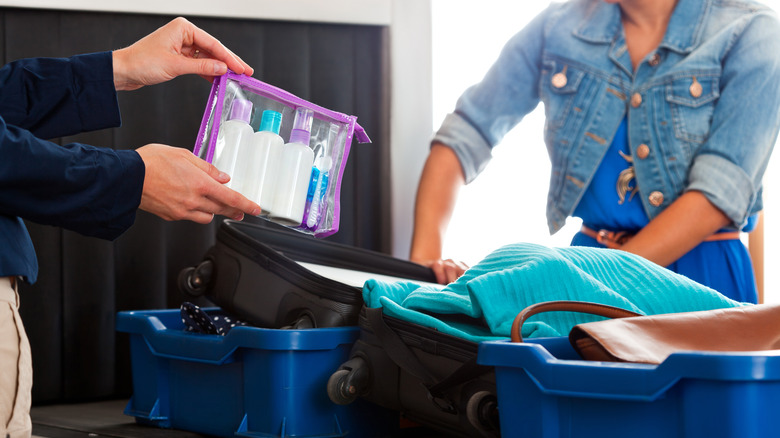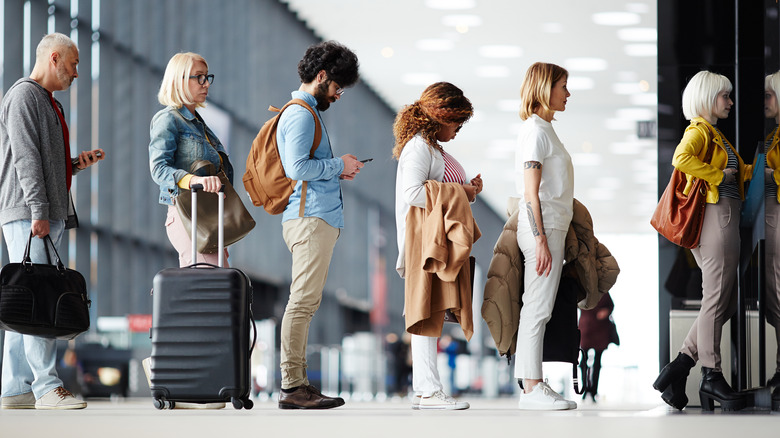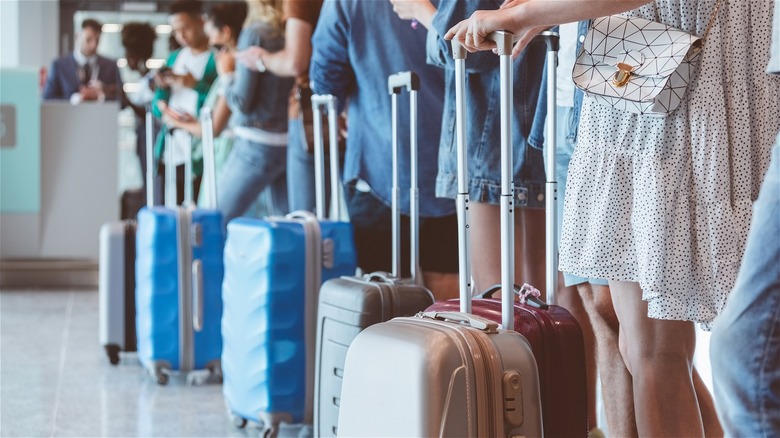The Big Change Coming To TSA's Dreaded Liquid Rule At This European Country's Airlines
Your flight is booked, your hotel reservations are made, and your suitcase is laid out and ready to be packed. The anticipation of leaving on a trip is part of the excitement of traveling. As you look forward to all that lies ahead of you on, suddenly your thoughts are interrupted by the terrible reality that it's time to pack all your liquids. Most travelers are familiar with the 3-1-1 rule from the Transportation Security Administration (TSA), which states that all liquids placed in a carry-on bag need to be contained in 3.4-ounce bottles inside a 1-quart bag, and each passenger may only bring one of these bags. It's important to pack your carry-on this way in order to get through security efficiently and not create a delay for yourself or those in line behind you. However, it appears that the U.K. is starting to retire this rule, to the surprise and delight of travelers everywhere.
While it may seem as though the 3-1-1 liquid rule has been the norm since air travel began, it has actually only been in effect since November of 2006. Earlier that year, British authorities discovered a plan to destroy 10 planes bound on transatlantic flights from Heathrow Airport to North America. The suspects intended to use liquid explosives that were disguised as average soft drinks. Restrictions on liquids in carry-on luggage followed shortly after this event. However, due to new technology being tested at U.K. airports, these restrictions are about to end.
New 3D security imaging
The new technology being implemented across the U.K. is the use of a computed tomography system, also known as a CT, as the new security process. Similar to CT scans performed in hospitals, the 3D image that is produced is more accurate than the 2D X-ray scans currently taking place at security checkpoints. Kevin Riordan, head of checkpoint solutions at Smiths Detection, explains that producing a 3D object provides more information for security analysts. "From a security point of view, they're able to make very accurate decisions about what the materials are in your bag: Is it a likely threat material or is it benign? That's better security, better decisions," he explains, per CNN. At the Shannon Airport in Ireland where the new procedure is being tested, the waiting time has been cut in half.
The British government has set a deadline to implement this new technology in all of its major airports by June 2024. Mark Harper, the U.K. Secretary of Transport, says, "The tiny toiletry has become a staple of airport security checkpoints, but that's all set to change. I'm streamlining cabin bag rules at airports while enhancing security," per Gov.UK. He explains that this new system will take some time to become implemented, but that the result will be worth it. "By 2024, major airports across the U.K. will have the latest security tech installed, reducing queuing times, improving the passenger experience, and most importantly detecting potential threats," Harper states.
Eventual rollout in U.S.
Of course, this development in the U.K. raises hopes that such a transition will take place in the U.S. as well. TSA explains to Frommers, "While we have [the new scanners] deployed at more checkpoints, we are years away from announcing a change to the current liquids rule." The reason for this delay in the U.S. is because policy changes would need to coincide with a rollout of new CT technology across the entire country. Henry Harteveldt, aviation analyst and president of Atmosphere Research Group, explains that this effort would need to be coordinated in order to keep things consistent for customers and to prevent confusion. "We as travelers ... want things to be reasonably similar," Harteveldt says. "Unfortunately, 3-1-1 is not going to go away tomorrow." This change is going to take longer, given the size of the U.S. and the number of airports in the country. "It's possible that in perhaps a five-to-seven year timeframe, we see the restriction on liquids go away," he adds.
It's encouraging to see airport security move in the direction of better safety measures and a streamlined customer experience. In addition, exceptions to the 3-1-1 rule continue to remain in effect, as some important travel items have always been exempt from TSA's liquid rules. Yet in the meantime, U.S. travelers should continue to pack full-sized liquids and aerosols in their checked luggage, while they anticipate the day when all airports will follow the U.K.'s example.


